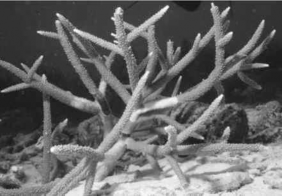4.8. CORAL REEFS
♤ Coral is actually a living animal. Coral has a symbiotic relationship (each gives something to the other and gets something back in return) with ‘zooxanthellae’ microscopic algae which live on coral [i.e. instead of living on the sea floor, the algae lives up on the coral which is closer to the ocean surface and so that the algae gets adequate light].

Coral
♤ Zooxanthellae assist the coral in nutrient production through its photosynthetic activities. These activities provide the coral with fixed carbon compounds for energy, enhance calcification ,and mediate elemental nutrient flux.
♤ The tissues of corals themselves are actually not the beautiful colors of the coral reef, but are instead clear (white). The corals receive their coloration from the zooxanthellae living within their tissues.
♤ The host coral polyp in return provides its zooxanthellae with a protected environment to live within, and a steady supply of carbon dioxide for its photosynthetic processes.
♤ There are two types of corals: hard corals and soft corals, such as sea fans and gorgonians. Only hard corals build reefs.
♤ The builders of coral reefs are tiny animals called polyps. As these polyps thrive, grow, then die, they leave their limestone (calcium carbonate) skeletons behind. The limestone is colonized by new polyps. Therefore, a coral reef is built up of layers of these skeletons covered ultimately by living polyps.
♤ The reef-building, or hermatypic corals can form a wide range of shapes. Coral reefs may be branched, table-like, or look like massive cups, boulders or knobs.
♤ While the majority of coral reefs are found in tropical and sub-tropical water, there are also deep water corals in colder regions.
4.8.1. Cold Water Corals:
♤ Cold-water corals inhabit deep, cold (39-55 degrees F), water. The United Nations Environment Programme reports that there are more cold-water coral reefs worldwide than tropical reefs.
♤ There are only about 6 different coral species associated in building with these reefs. The largest coldwater coral reef is the Rost Reef off Norway.
